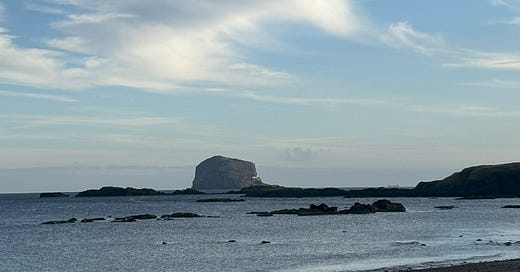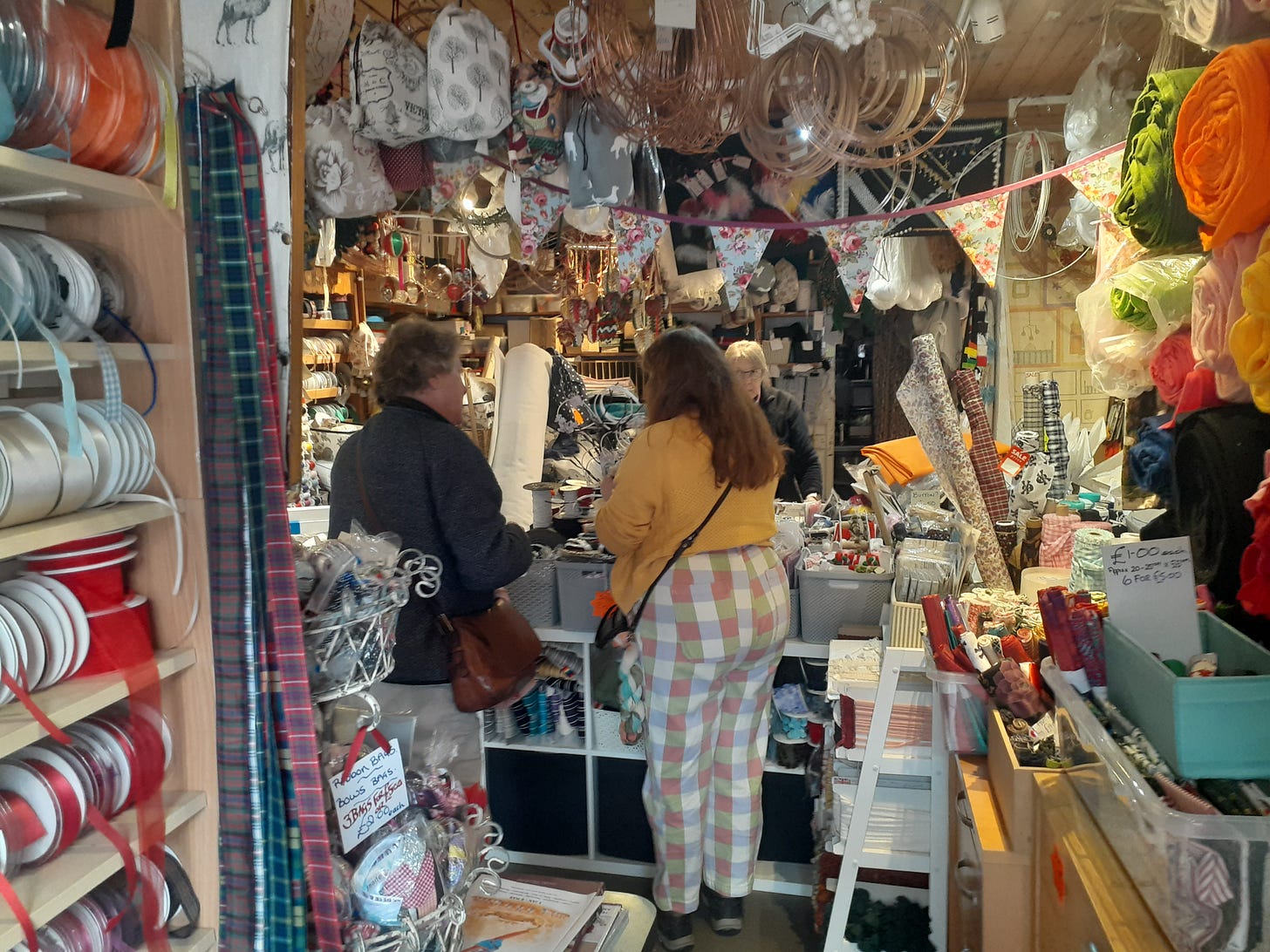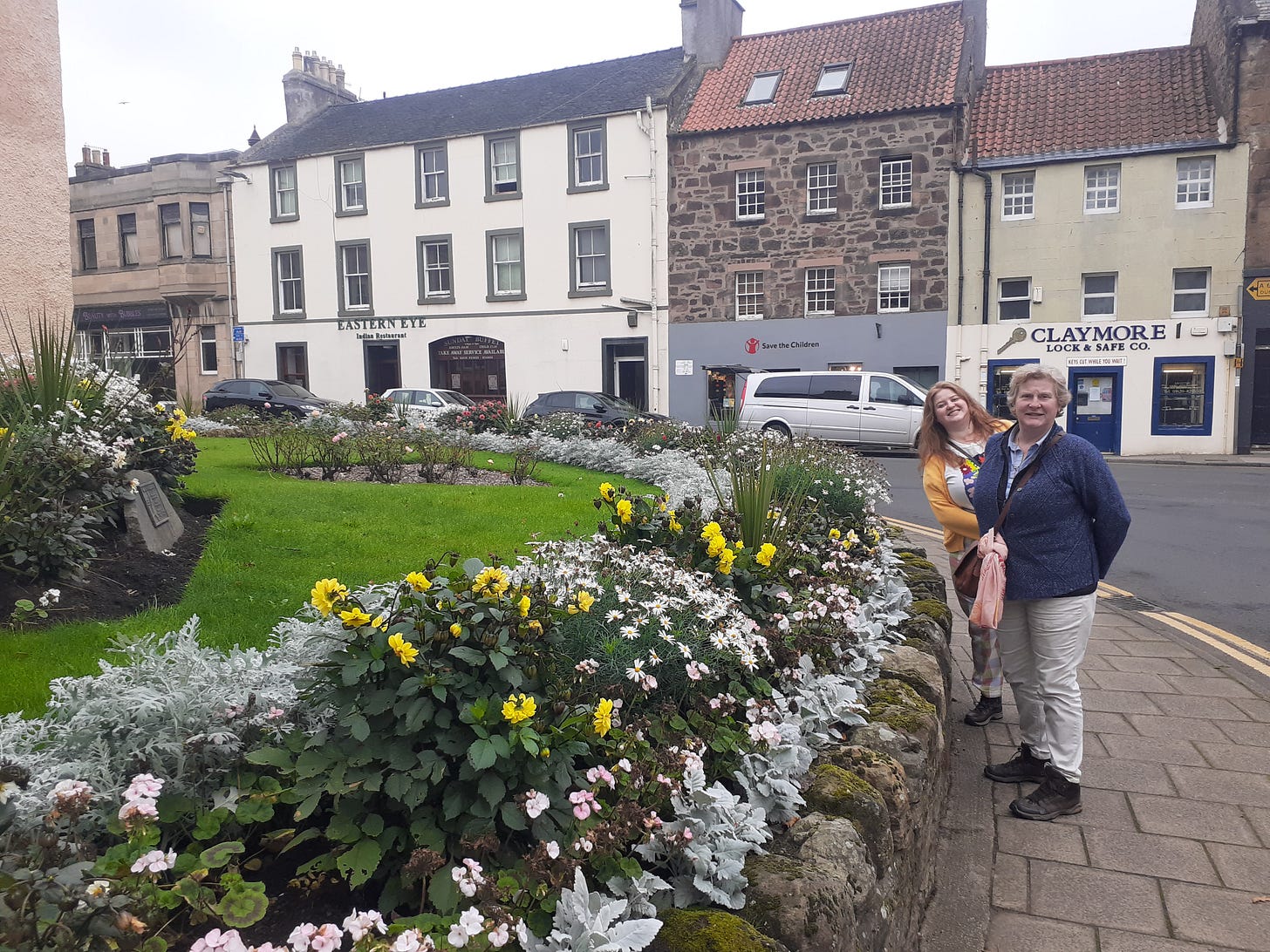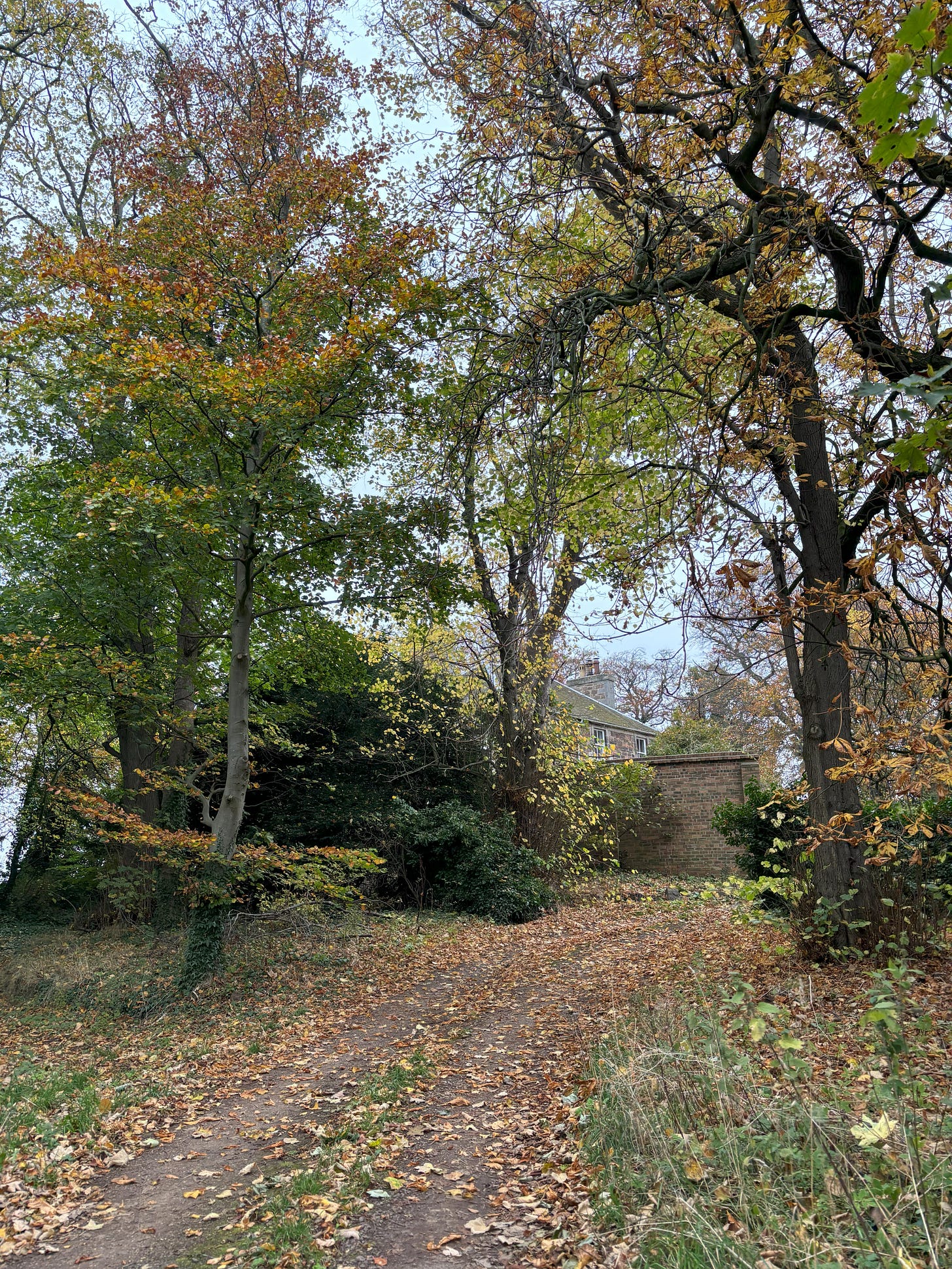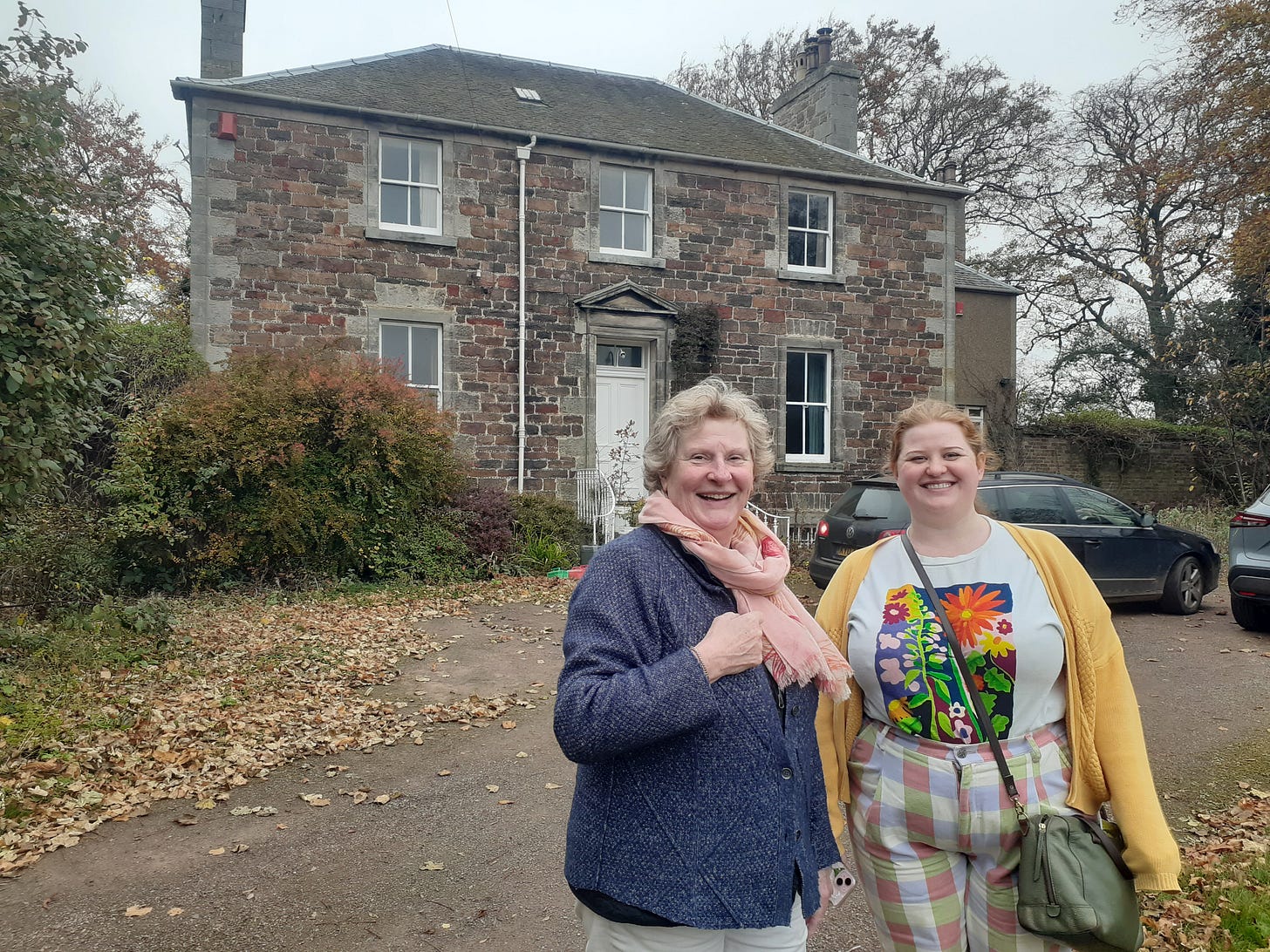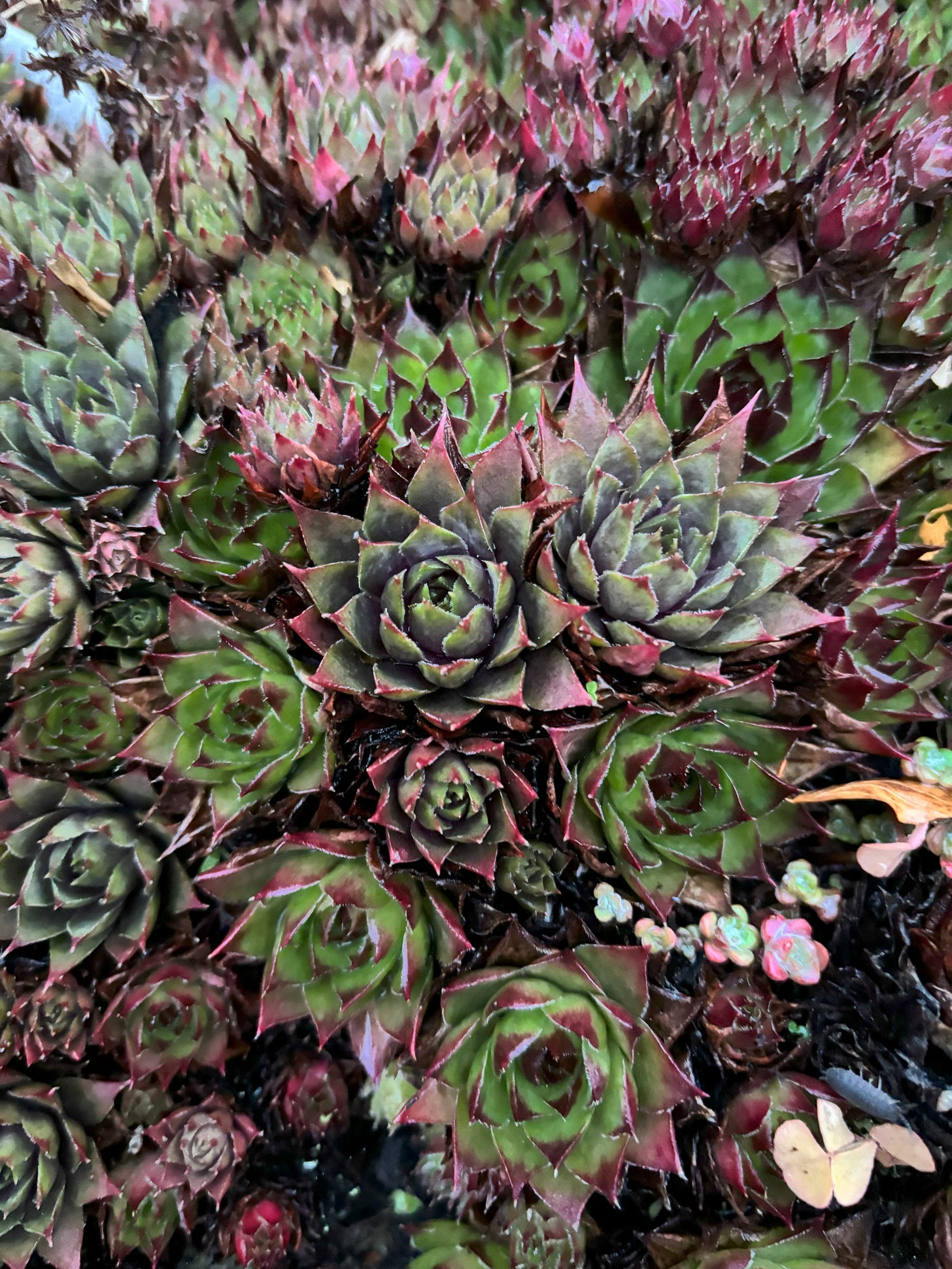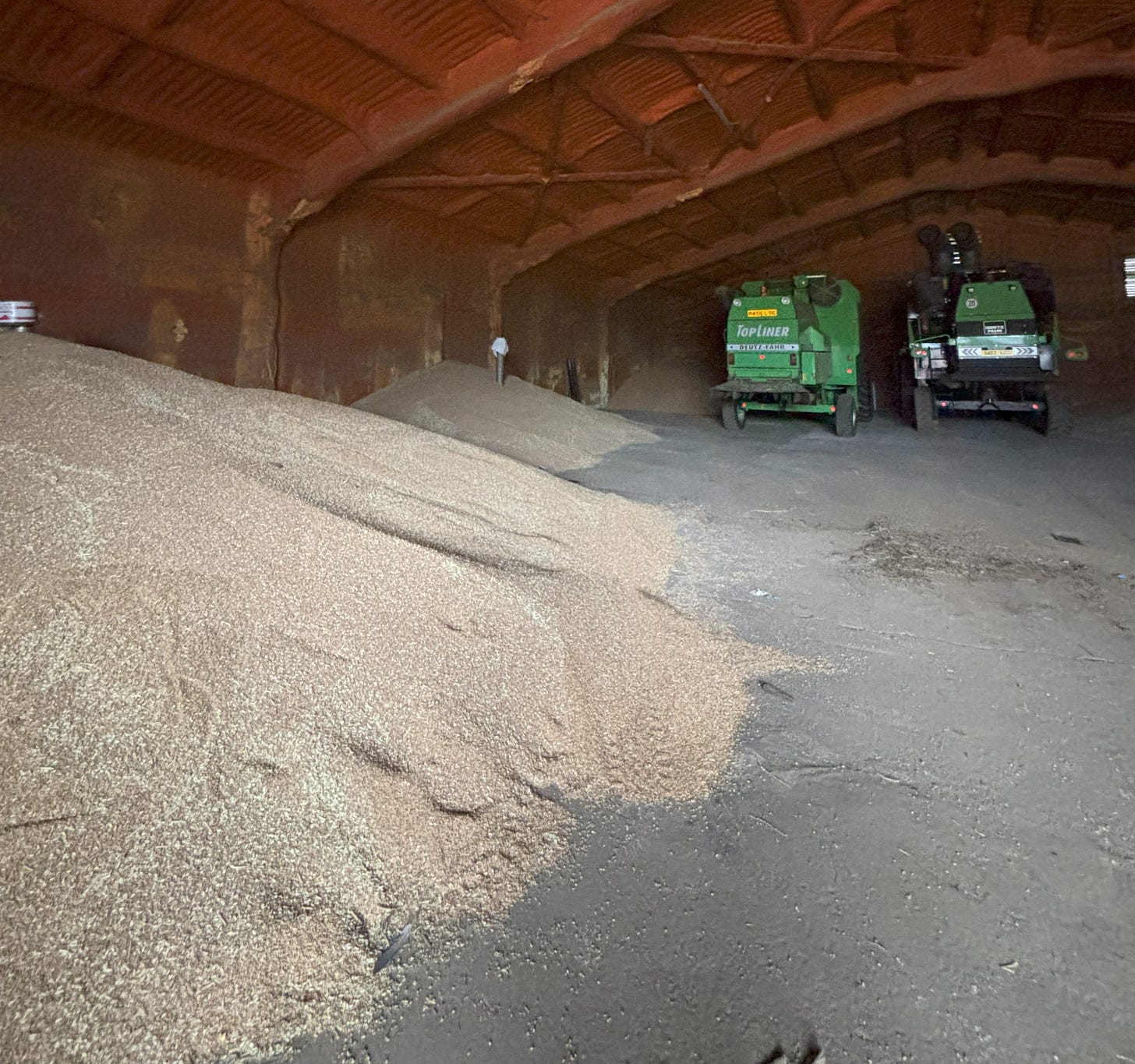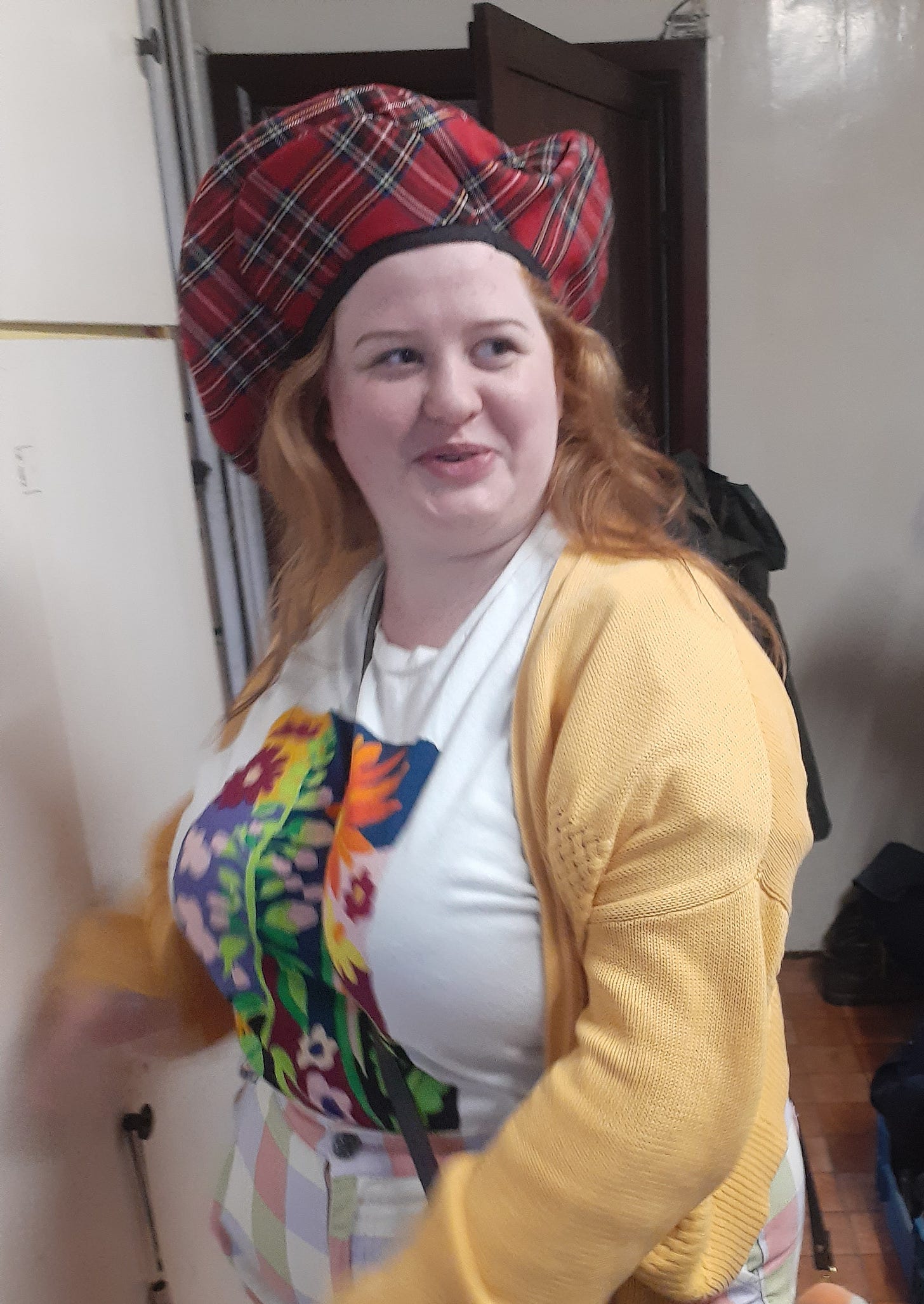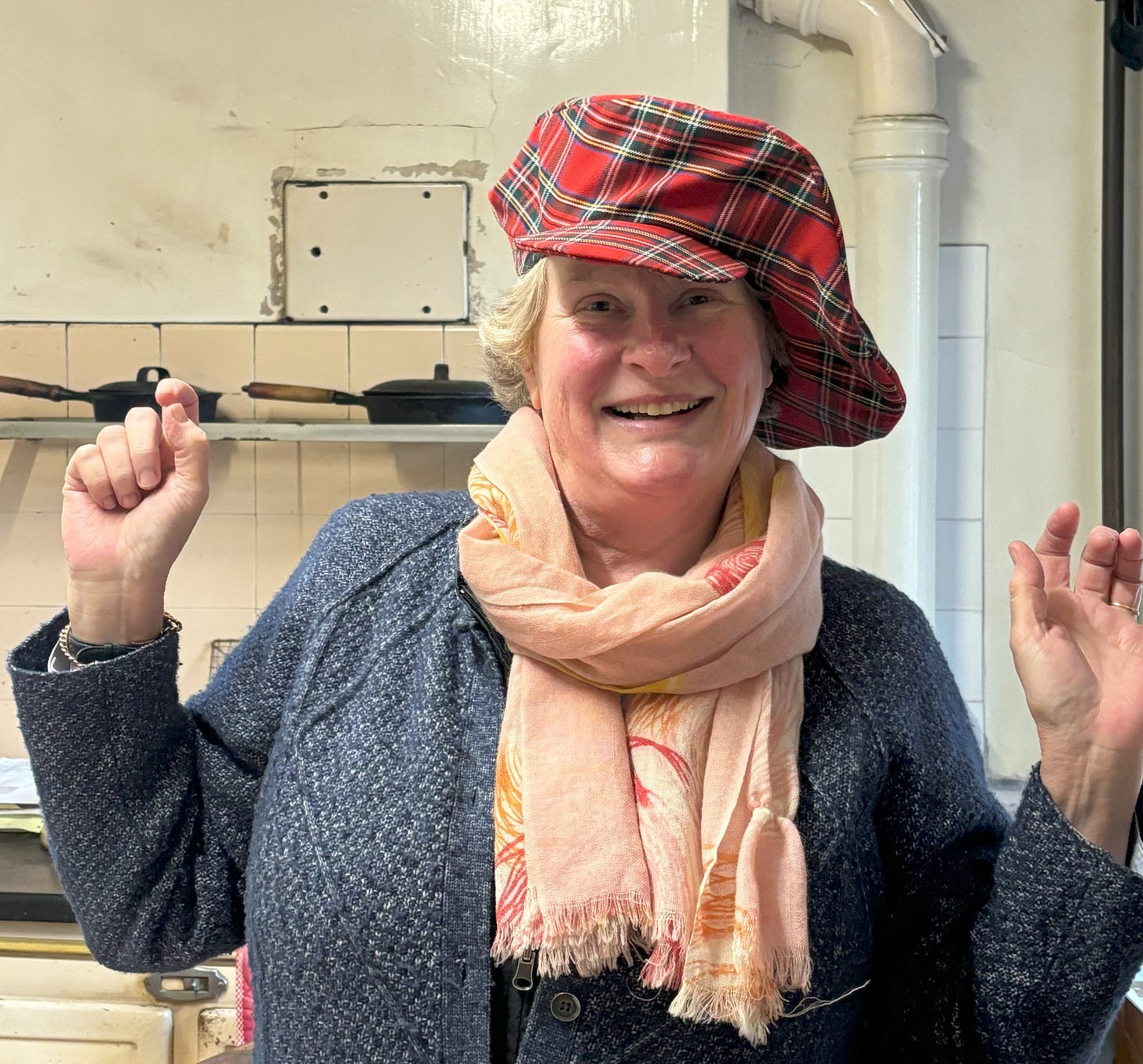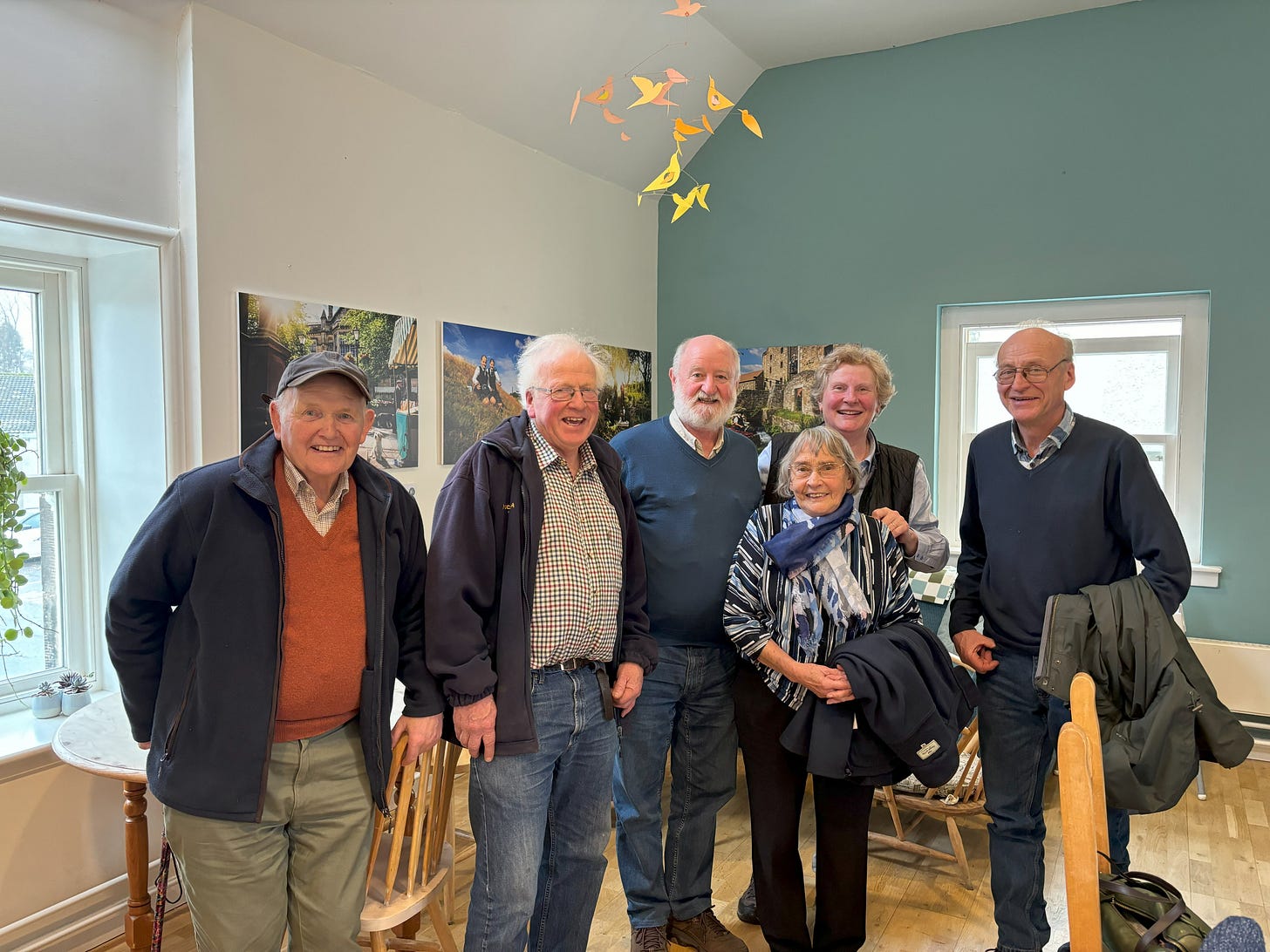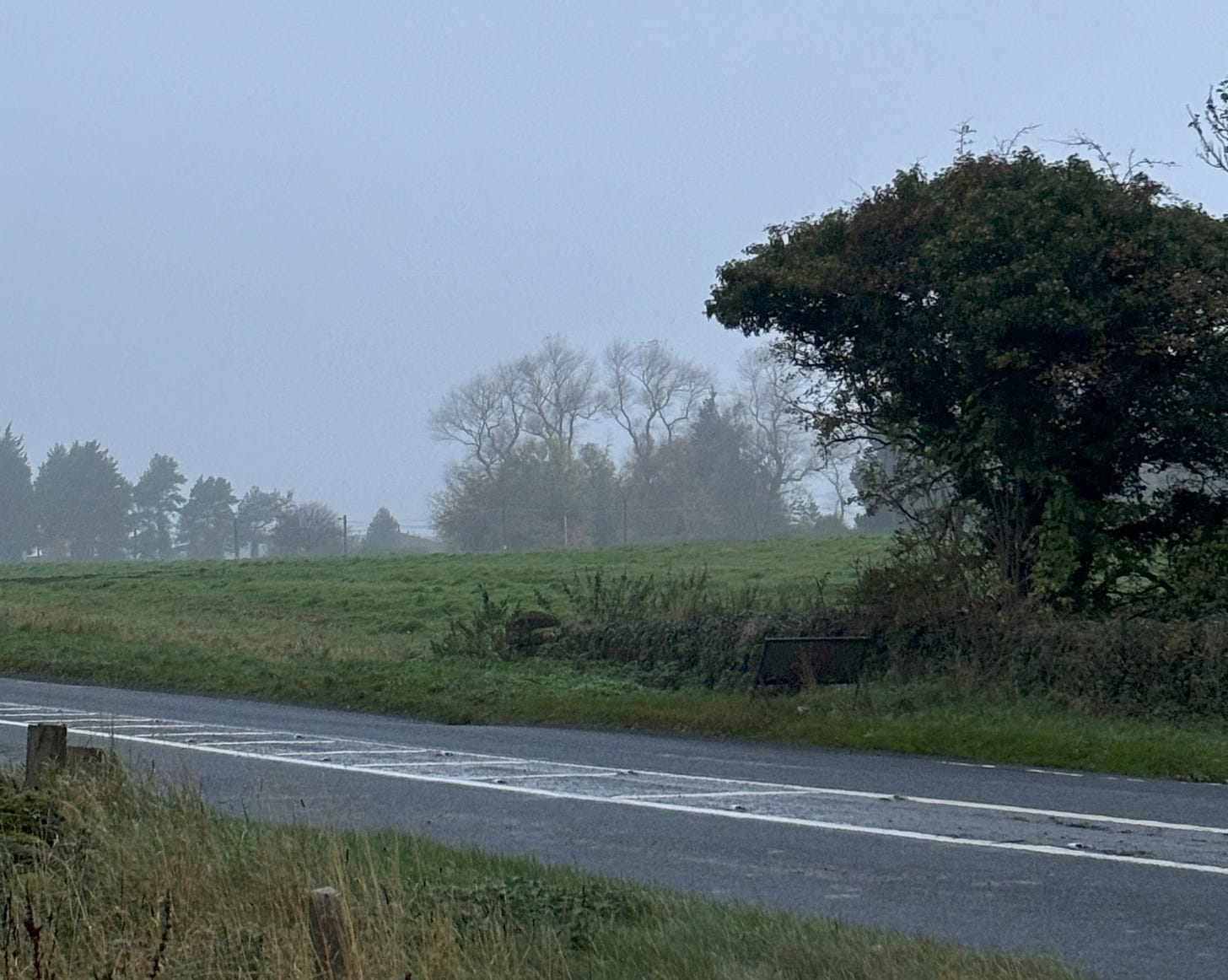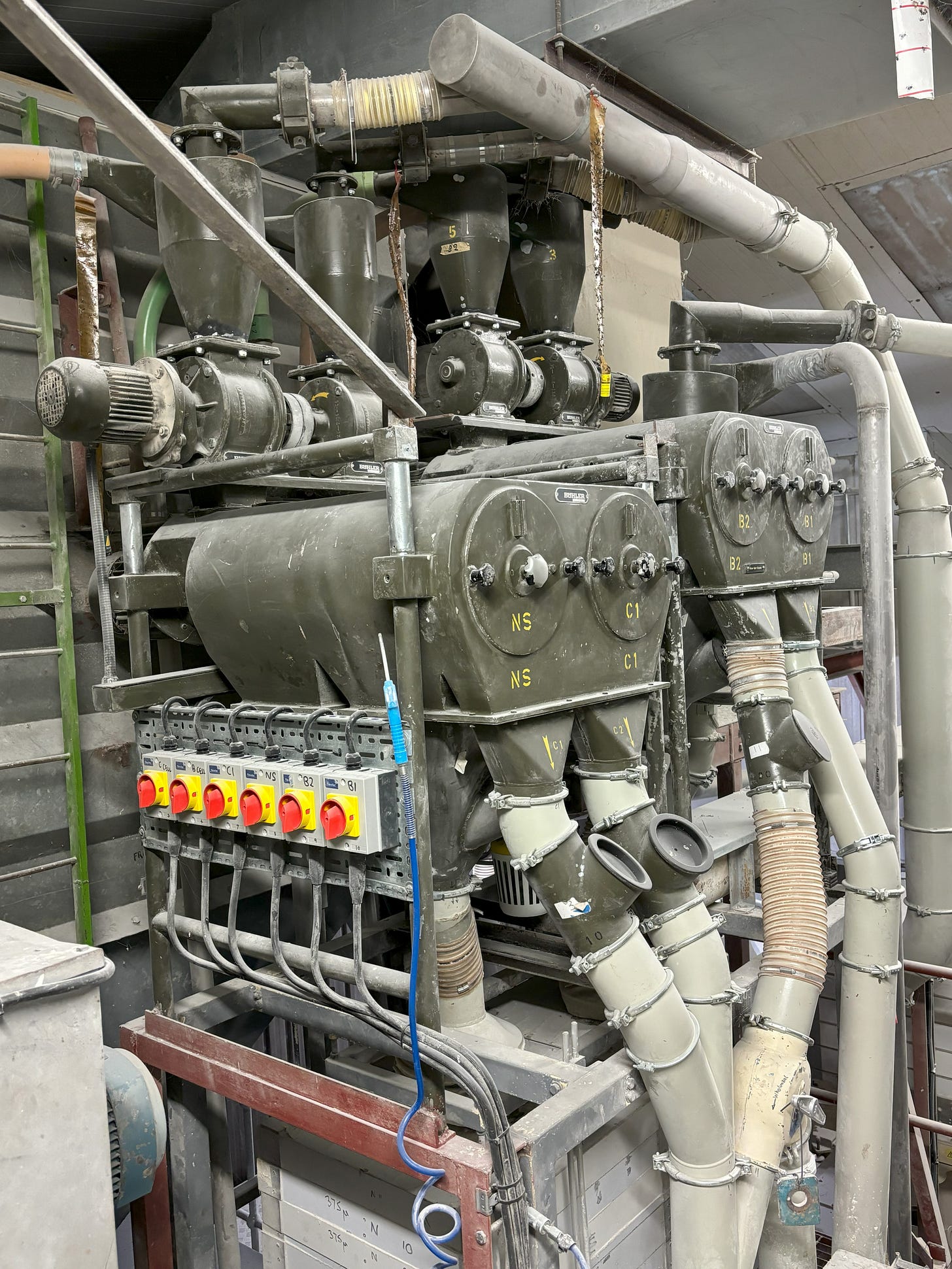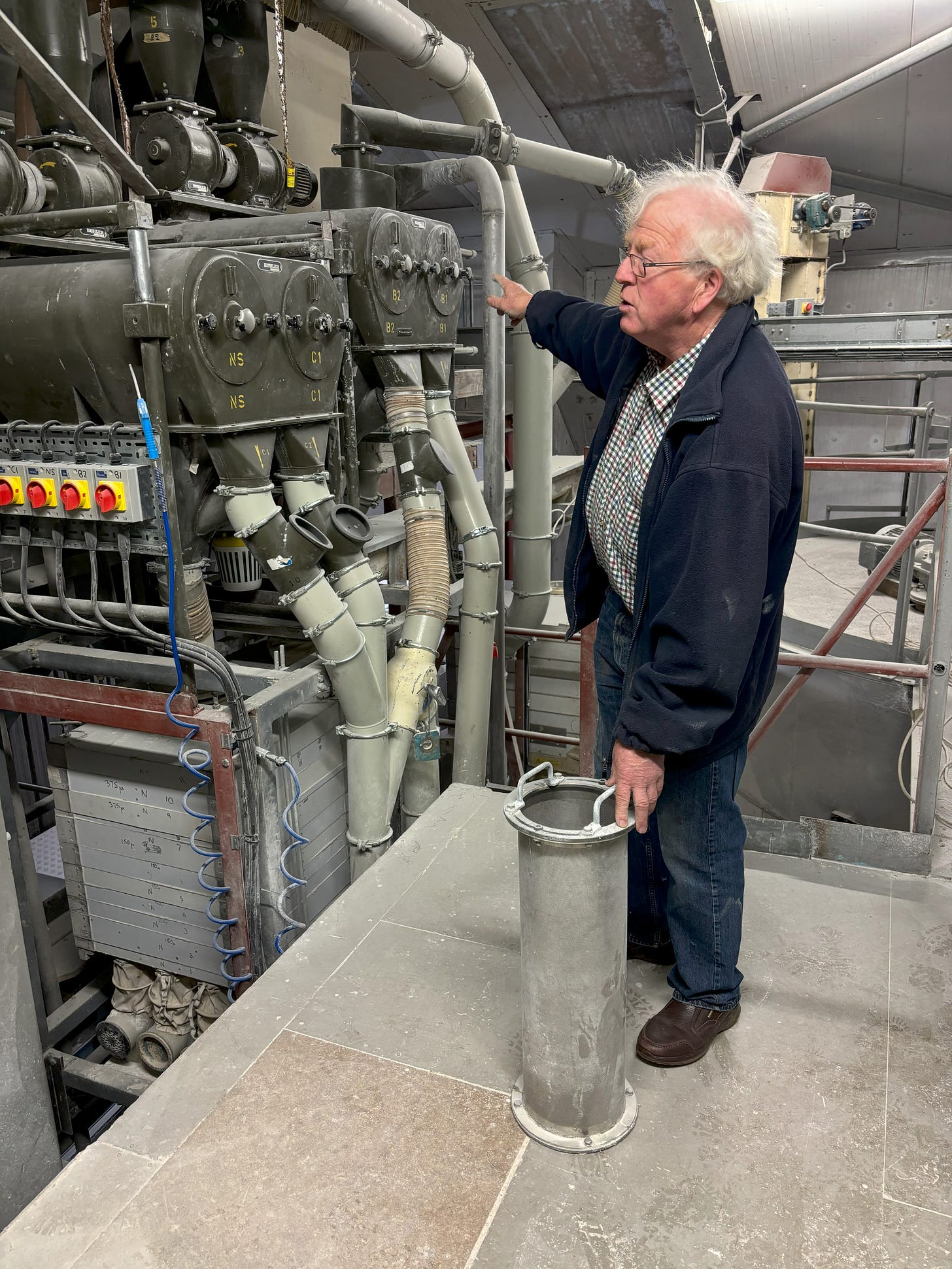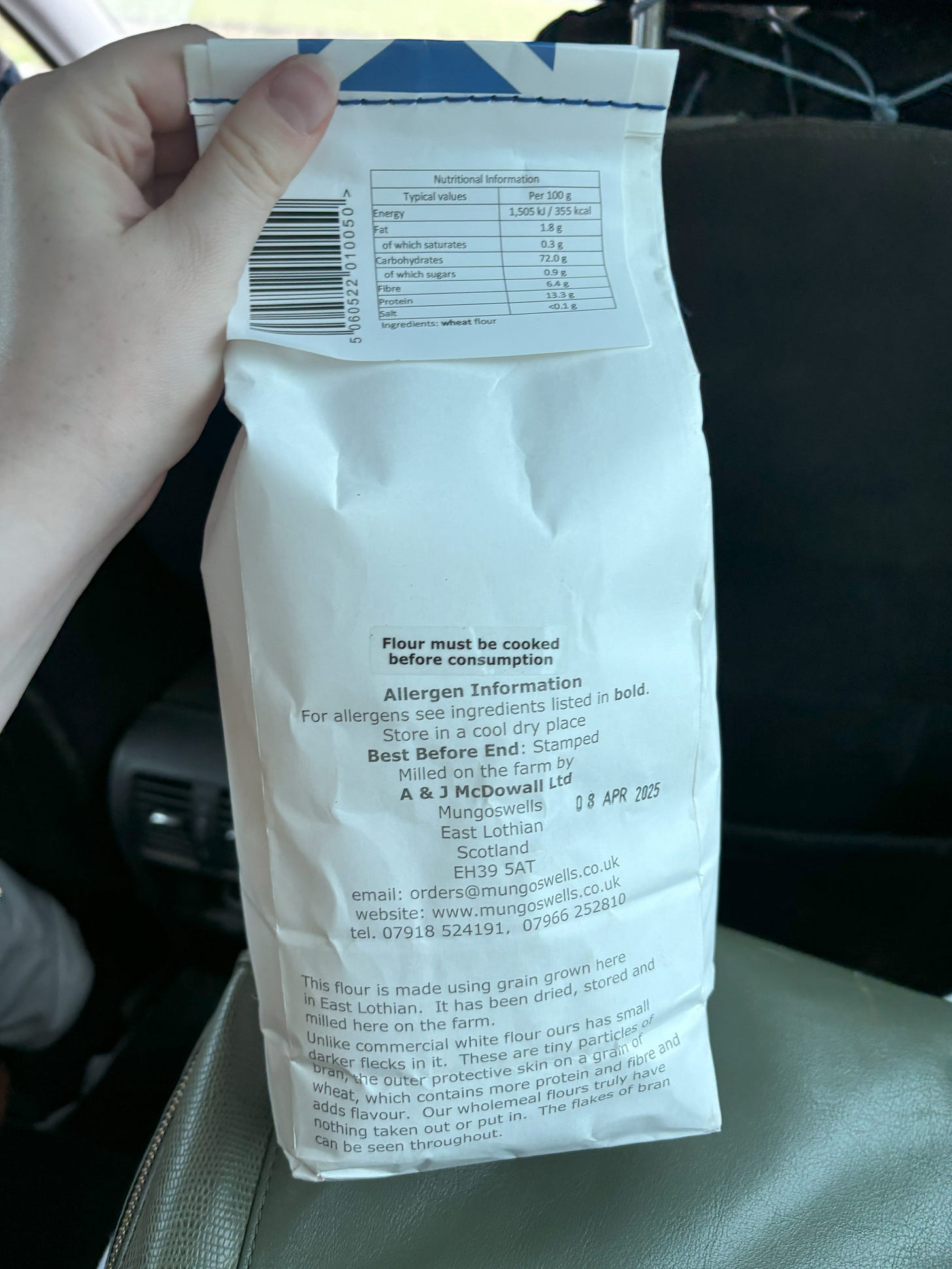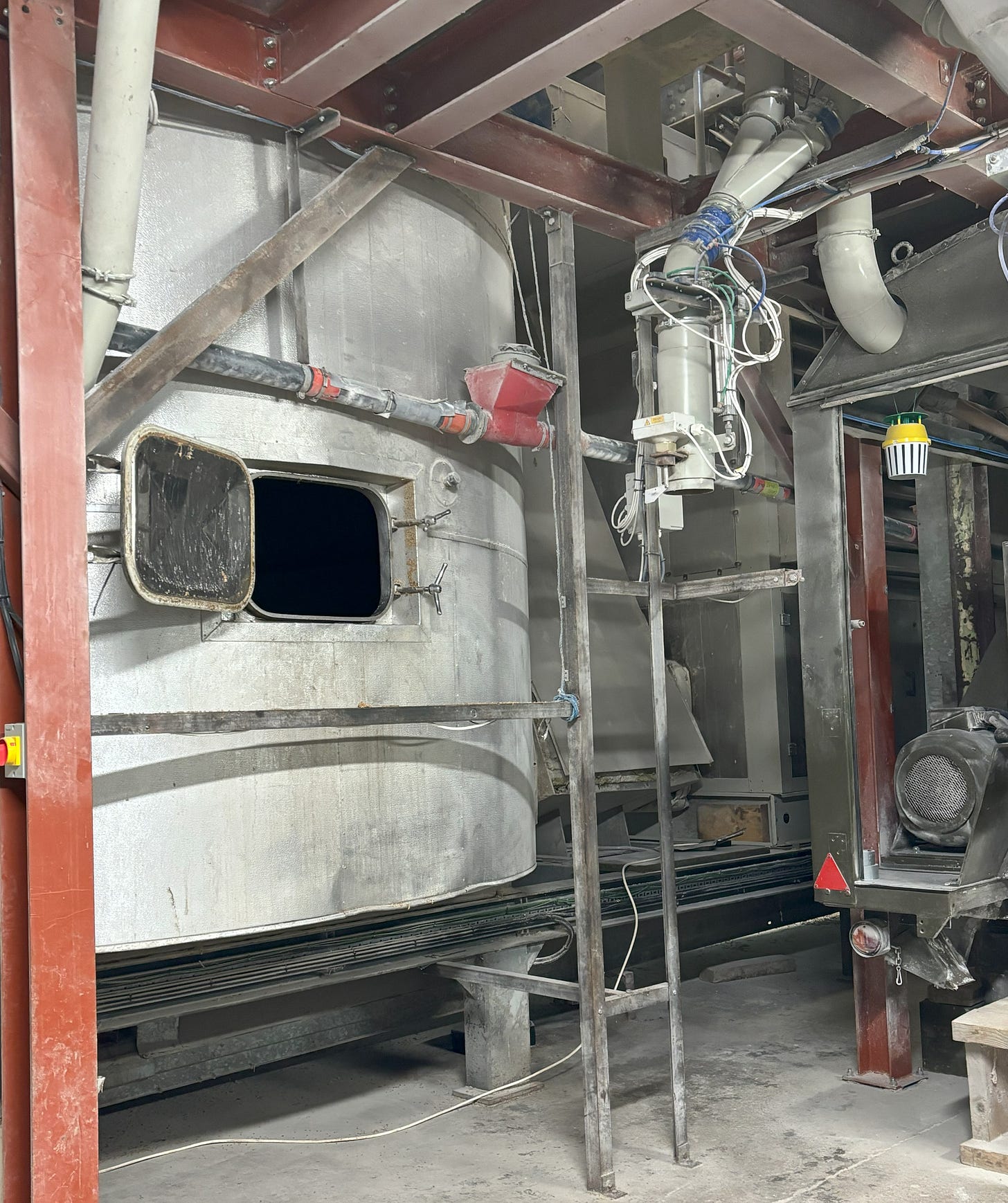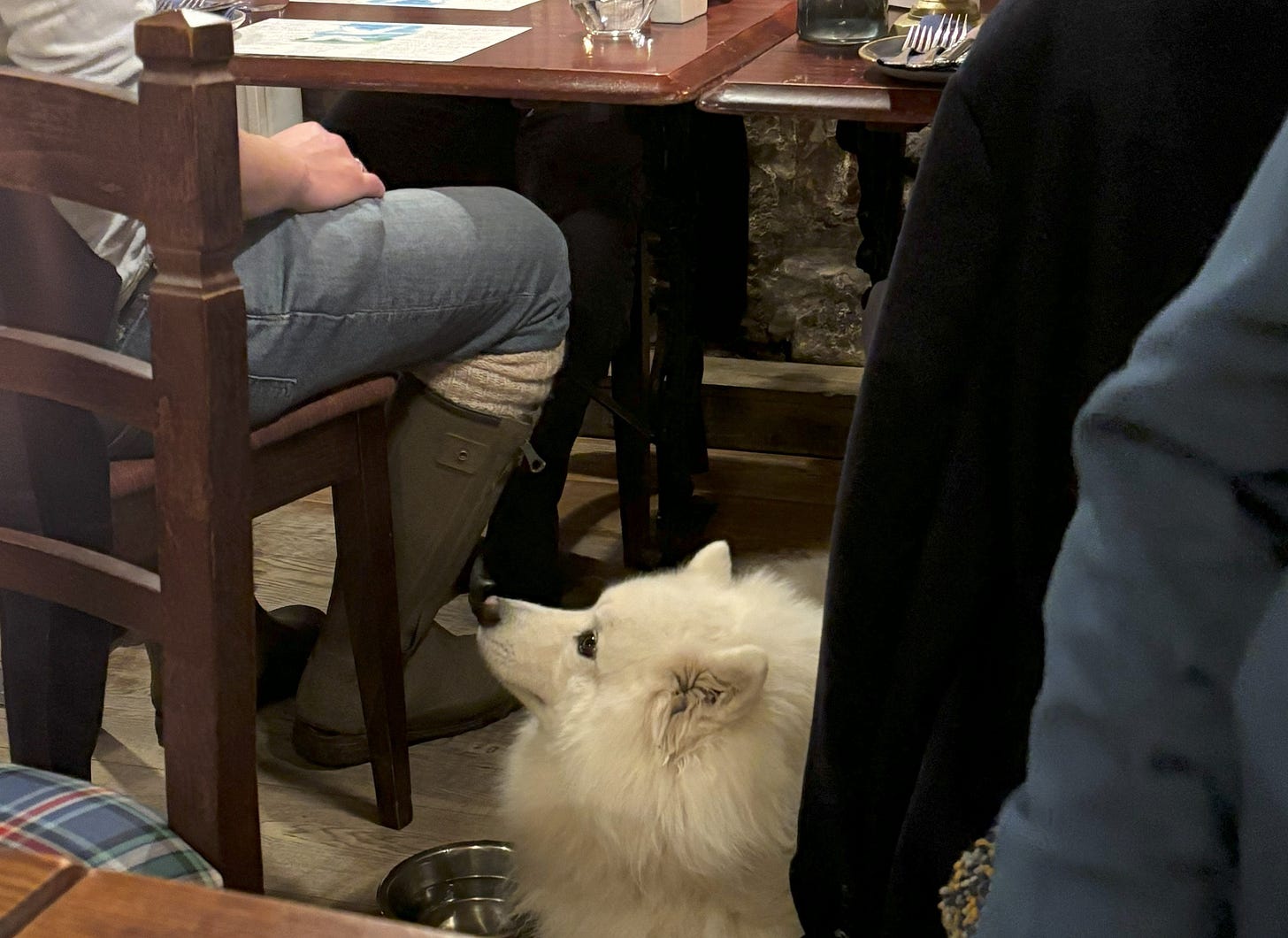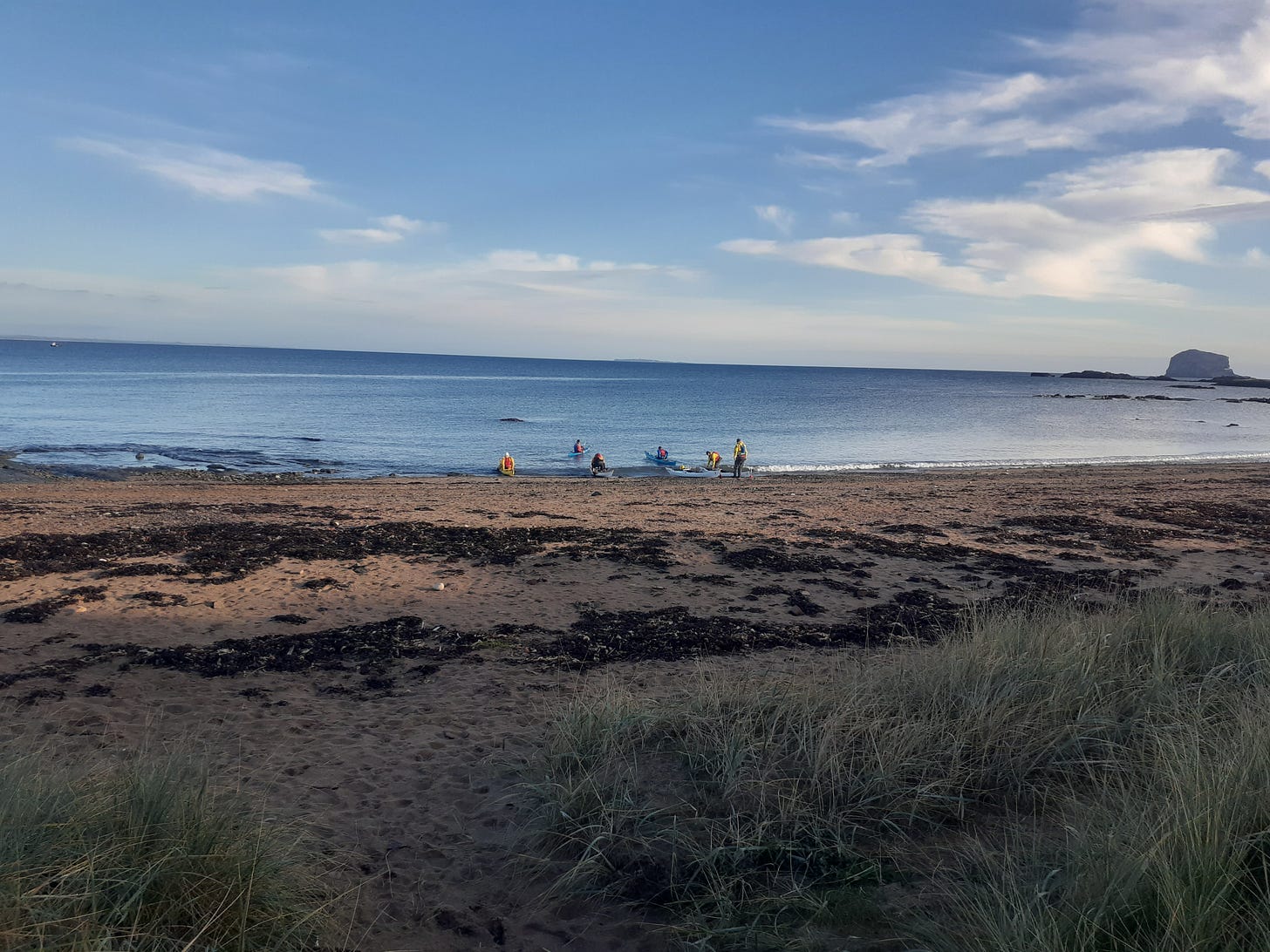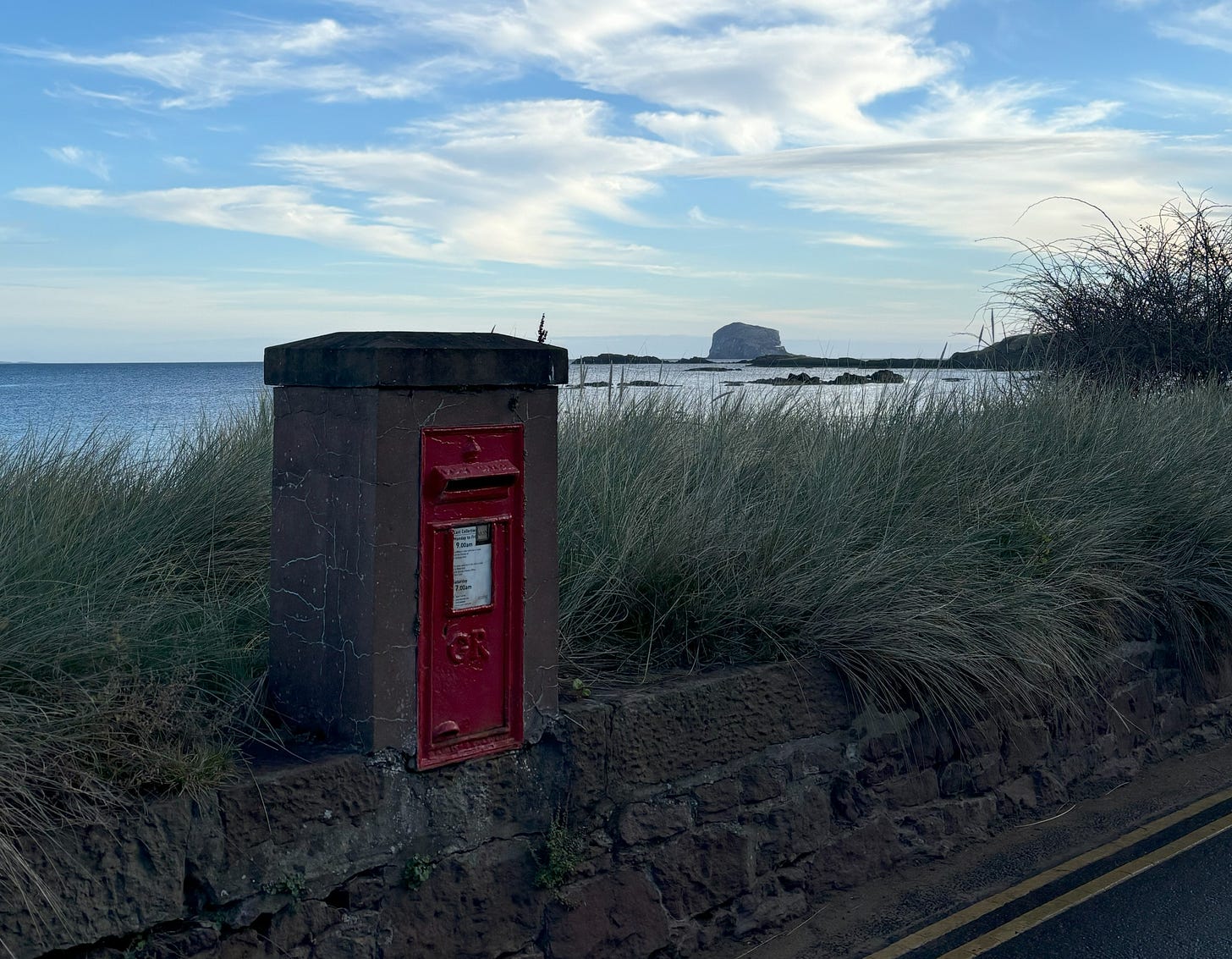Travelling the World 7 - Mungoswells
These not quite coming out “real time” - some of the urgency has gone now we are back home, and life goes on busy as ever. There are still 4 possibly 5 episodes to go. Five if I can get Beth to “do” Chatsworth House in detail - she took lots of great photos.
Ruth is putting in great effort sorting my rough outline which was almost “real time”. Still, I feel the effort is well worth it and not too boring for the readers. Hope there are still a few of those.
Friday 25/10/24
I’m writing this in our very cute but somewhat impractical attic flat right on the beach in North Berwick in Scotland. It’s not a bad floor plan but you have got to account for the many sloping ceilings and odd angles that appear. It makes for an interesting stance for a gentleman at the ensuite loo as the roof slopes in right above it. It’s not so bad when sitting down!
It’s 7 o’clock in the morning and still quite dark outside. The tiny windows in the sitting room give a view of the beach and various walkers are already out with their dogs. I see the light of a boat far out in the firth coming around a great rock Bass Rock. The days seem to have gotten short even in the few weeks we’ve been here - you definitely get the feel that ‘winter is coming’.
The Bass Rock, or simply the Bass[5] ( /bæs/), (Scottish Gaelic: Creag nam Bathais or Scottish Gaelic: Am Bas) is an island in the outer part of the Firth of Forth in the east of Scotland. Approximately 2 km (1 mi) offshore, and 5 km (3 mi) north-east of North Berwick, it is a steep-sided volcanic plug, 107 m (351 ft) at its highest point, and is home to a large colony of gannets.
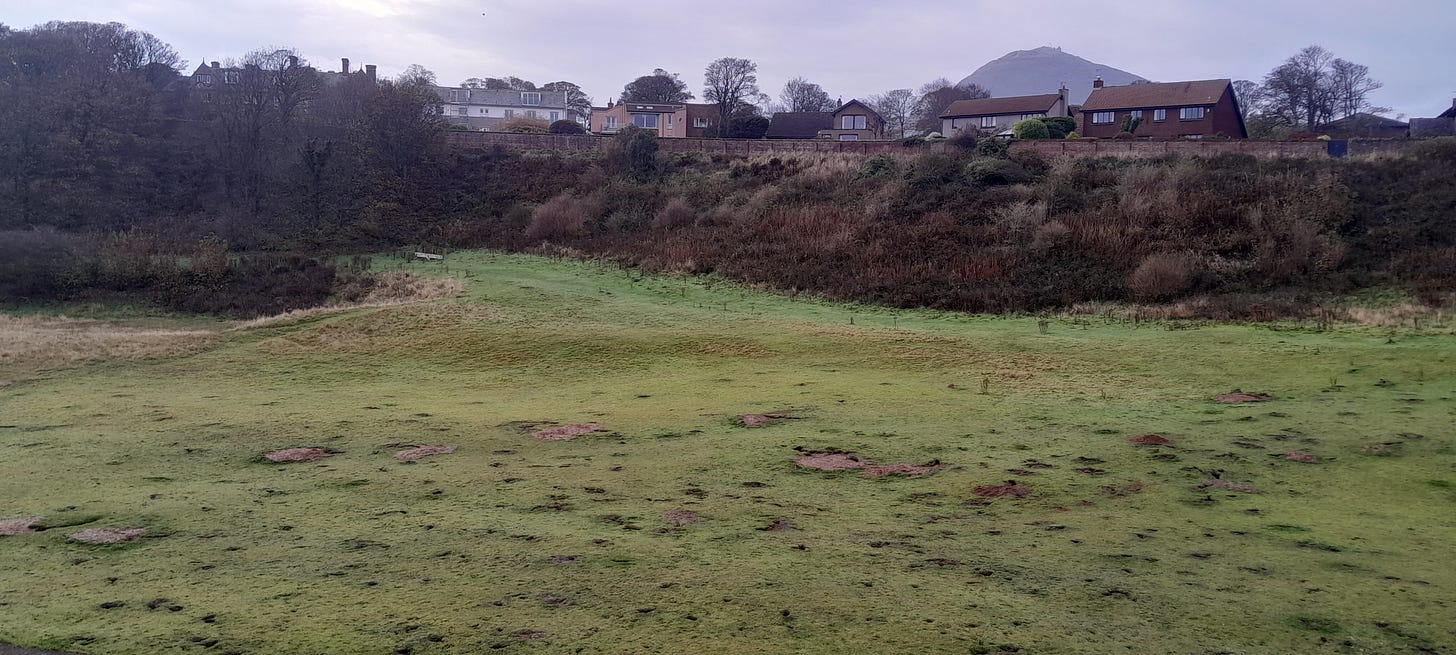
It’s a slow start to the morning and we miss our 9:30 catch up with Angus McDowall at his nearby farm “Mungoswells”. We reschedule for 11am giving us time to refuel the car and find a repair kit for Beth so she can darn a pair of linen trousers which have failed her! She has spotted on Google (‘as you do’) a textile supply shop in the right general direction. A course is laid in and we head for this shop near Drem. It turns out to be a “fulfilment” centre packaging up on-line orders, not a retail shop at all. The business is housed in a steading (a group of farm buildings) which appear to have been repurposed into modern businesses beside the original farmhouse. It all looks quite prosperous and a good use for old buildings! Anyway, after a very useful chat with the lady there we head for Fabrications in the nearby town of Haddington, the local town for Mungoswells.
Beth comes away with a small kit of embroidery thread and needles, some pieces of fabric, a darning frame, and scissors. She has no excuses now!
We head on to Mungoswells about 10 minutes away. There’s some panic when I can’t see the driveway entrance and try to drive down a side road - I should mention that Mungoswells is on a bend on a very busy commuter road into Edinburgh and there always seems to be speeding traffic up your tail!
Anyway, we drive into the still imposing but somewhat tired looking house and garden where Ruth spent several months as housemaid in 1985. Angus is nowhere to be seen so we take ourselves off to the ‘steading’ across the busy road to track him down. You do feel you are taking your life in your hands making the mad dash across!
We find Angus in his overalls and head off to inspect a big shed with various piles of grain, mostly wheat for his flour milling business. Each pile has an ingenious perforated tube topped with an extraction fan set in the middle of the heap. Angus explains that this isn’t exactly to try to dry the grain but rather cool it after harvest. It’s curious how different things can be done in a cold climate! He was most interested in some rape or flax seed that had just been harvested from a small patch planted it sounded almost by accident, or as a trial. It’s not an impressive tonnage but if “organic” could be worth an impressive amount.
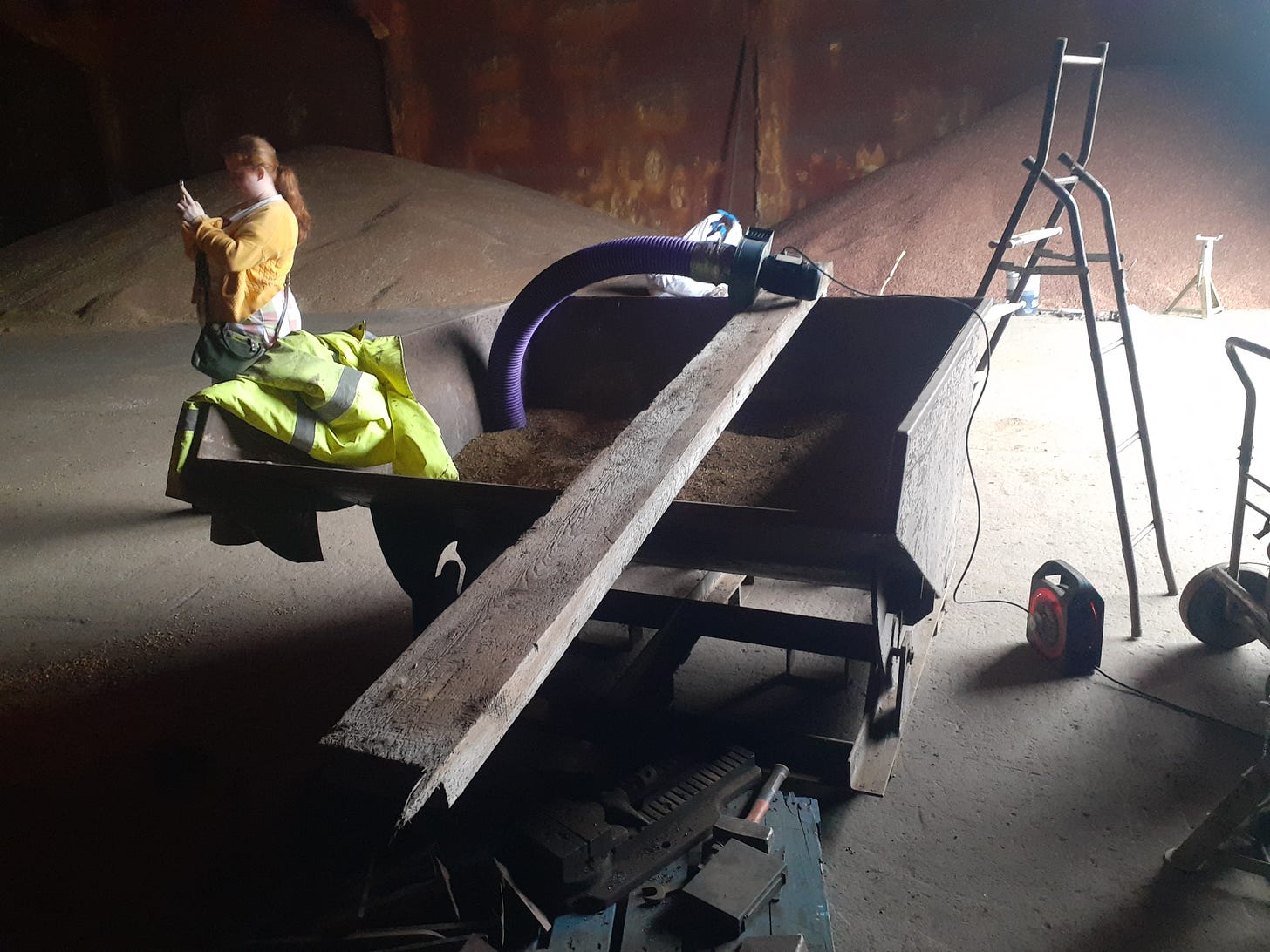
We head back to the house as Angus has organised for us to meet people for lunch back in Haddington. As we walk back up the driveway, we notice a rain gauge out the front of the house. We comment that it wouldn’t work back home as it is simply a glass cylinder with no rain collection funnel. We would rarely get enough rain/water in it to get a reading. Angus agrees that it is useless but for a different reason we would not have picked - the glass will break in the first frost! “A gift,” he says with a bit of a scoff.
Talking of gifts Angus presents Ruth with a ‘welcome back to Scotland’ package. Inside is a very colourful, very tartan Tammy cap! Angus apologises for only buying one - we are relieved that there is only one as it’s hard to see it getting much use! Actually, I can see myself wearing the hat around Ashgrove and at the VAQ. Perhaps it is time I developed some (more) eccentricities!
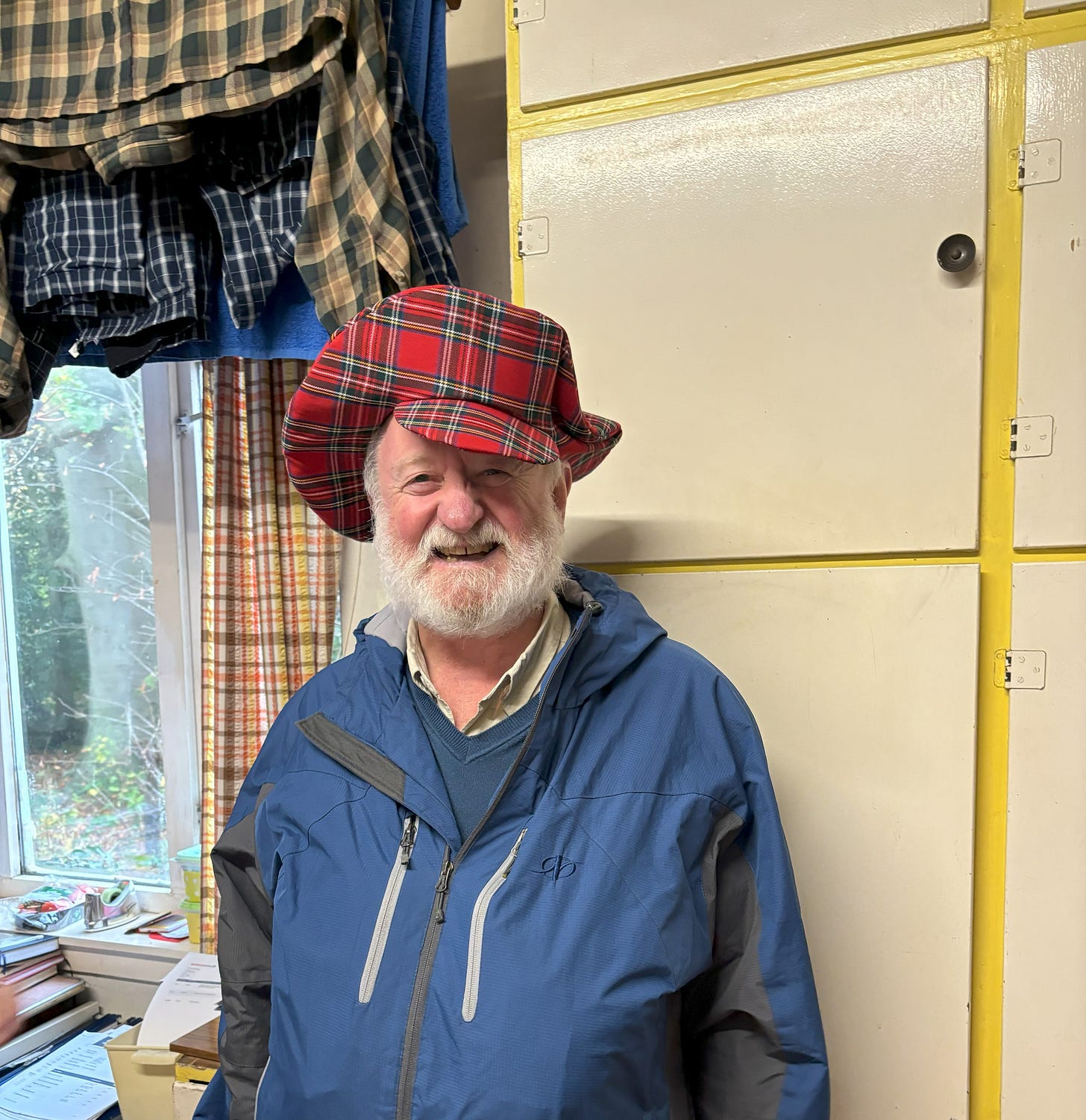
We head back to Haddington where we are to meet up with Davey, (who was the grieve in Ruth’s time - Farm Grieve: found in Scottish census records, a manager on a farm overseeing the work of other workers.) his wife Helen, and Angus’s younger brother Michael. We pile into Angus’s classic farmer’s car - a slightly dodgy and very dusty VW station wagon with a couple of sacks of tatties in the back. We take off at an impossible speed for a mercifully short run into town. The cafe (the Loft Cafe and Bakery) uses Angus’s flour and it turns out to be quite a big place offering simple food at what didn’t even look like outrageously expensive prices. Angus very kindly picks up the tab.
I sat next to Michael McDowall who I had not met before, and we had a great yarn. He is also a farmer on a place not far from Mungoswells but it’s on steeper country which is not as versatile or fertile. For many years he worked full time as a computer programmer on a cancer treatment tracking database for the health service. We got into the weeds a bit (software development details) with his claim that he wrote software to write software so could implement things quickly. I think I got it - he must be a clever bloke. Some talk about the futility of his work as management took no notice of the reports he compiled. He also noted that the NHS used to get a performance score of 70 or 80% but it’s now much lower. Anyway, he was made redundant in 2010 and has since been “on the farm”.
Michael still has most of the farming work done by a lessee, so he concentrates on maintaining the property and dealing with weeds. He is evidently a committed conservationist, and tracks birds, even moths and other insects on the farm. He’s authorised to band the birds and records and submits his data - an undertaking he takes very seriously.
I suspect Michael and my feelings on politics would be similar. We marvelled at how so many people have abandoned facts, science and good sense to lead the world to Brexit and Trump. We both feel that education has something to do with it.

We’re back in Angus’s VW and off back to Mungoswells. Did I mention that with the bags of tatties in the back and a full load of passengers the VW drags something on the ground at speed bumps? Also, he is very apologetic about the “ping ping ping” of the seat belt alarm which he claims will stop after a while and if you go fast enough! He’s right about that as he negotiates the narrow roads at speed in some light rain and fog - the alarm does go off!
We stop briefly in the kitchen at the Mungoswells before getting a full tour of the flour mill. You would have to say the kitchen is showing its age. The ESSY coal burning stove (pre-dates World War 2 I think) has a problem and he has not fired it up this season. There is also apparently a problem with the heating so the house is getting cold. He talks about piping hot water from the furnace that’s located across the road in the steading and heats the six farm cottages which are occupied by staff and their families. This furnace burns wood pellets made on site and has apparently worked very well for many years. “A bucket lasts ages,” he says. (Took me a while to realise he is talking about a front-end loader bucket!). Angus mutters about the aggravation of getting a pipe across/under the road and into the main house but obviously something will have to be done before winter sets in - perhaps the old ESSY will have to be fired up after all! The kitchen is in any case basically unchanged from Ruth’s days. The clothes drying rack with its impressive load of washing still hangs from the ceiling above the stove.
We take our life into our hands again to cross the road back to the steading. In Australia we would give a road like this with farm buildings and pedestrians about maybe a 50km speed limit. Here it’s 60mph (100km/h) and busy - we go for it!
We meet with one of his workers Ian who has been on the place for 42 years and remembers Ruth’s days at the farm, including the memorable tattie harvest of 1985 - one of the wettest they remember. (Ian’s 42-year service puts the tenure of brother Matthew’s Old Talgai farm manager Mark to shame - he’s only been there 25 years!) Ian jokes that Angus says he has to give 10 years notice before he can retire as he has ‘the knowledge’ of where everything is!
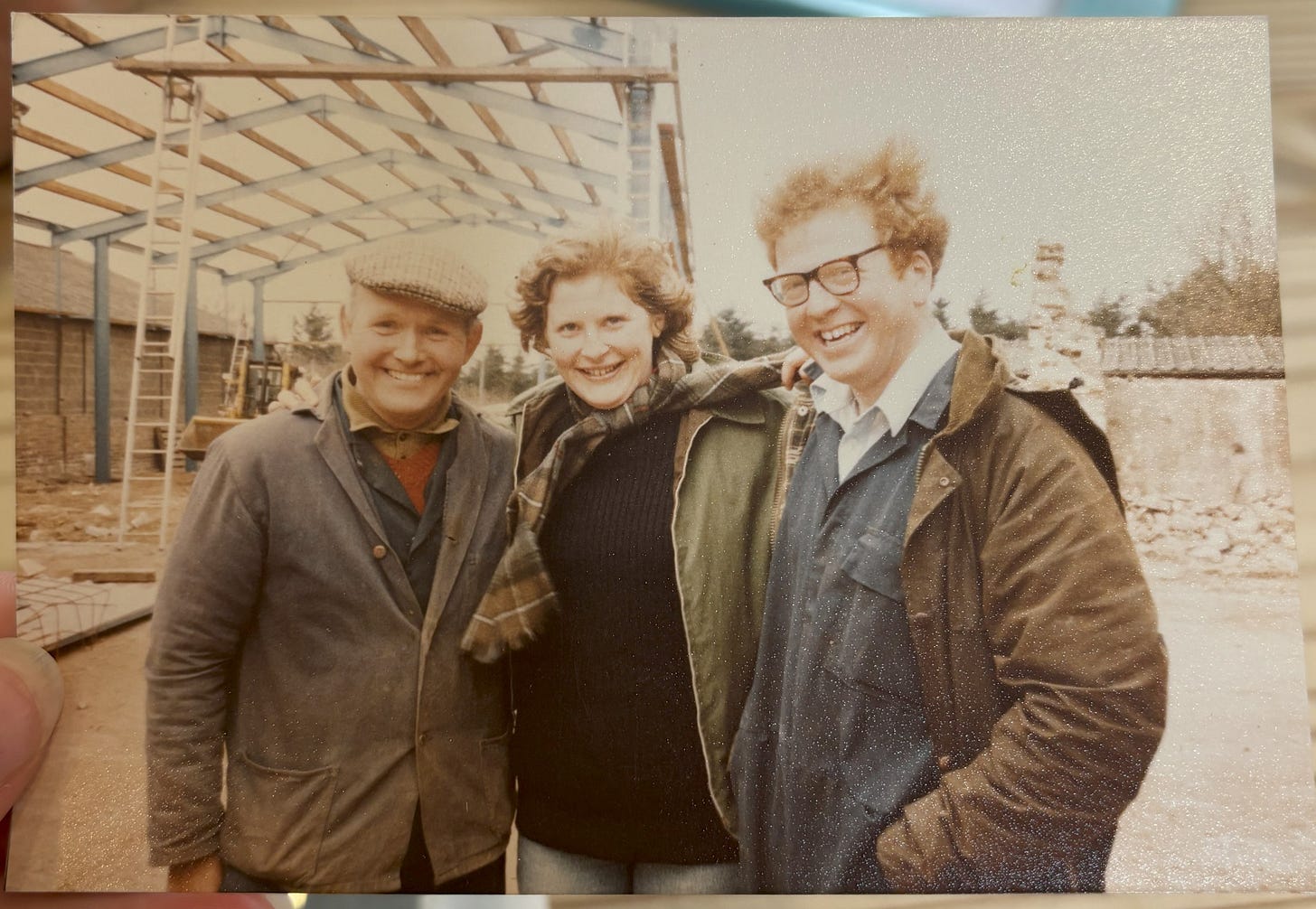
We stand about discussing things the way farmers will, mostly about the gun/nozzle irrigator with its huge 4 or 6inch hose reel standing in the yard. We are surprised to discover that they need to irrigate in some seasons. Discussion turns to the putting down of the bore on the advice of a diviner who used a crystal pendulum over a map on the dining table (after first checking for any water pipes under the floor). The general area is found on the map, that area is then blown up on a photocopier and the process repeated until four likely bore spots are located. Which one to drill first? The diviner can’t or won’t say - perhaps a convenient out? The first two holes are dug with no result before the third goes down and a geyser of water gushes out! This bore has been supplying the irrigation water for many years. Angus is a bit worried that it was cased with plastic which may eventually fail. This could be a problem as the last time he needed to raise the pump a four-ton forklift had to be called in. (My recounting of this tale must not be taken too accurately what with my poor recall and possibly Angus’s embellishment, but I hope I have got the flavour of it.)
We move inside a huge shed to inspect Davey’s ‘toys’. Davey (the retired grieve at Mungoswells) does up old tractors back at the farm, taking them to ploughing events around the countryside. He also helps out driving the more modern tractors when they need a hand at harvest time.

There’s lots of gear in this shed. There’s mate’s boat (Angus admits he should get onto him about moving it as it has been here a while), Davey’s tractors, and a big flatbed trailer which is loaded up with all the gear needed to host the monthly Haddington farmers’ market where Angus has a small stand selling his flour. The trailer apparently trundles into town behind a tractor, mercifully at 4:00 in the morning, so it doesn’t block up the roads too much.
We move on to inspect Angus’s main obsession - the Swiss Army Portable Flour Mill. Well, that’s what it started out as. The original trailer-mounted milling components are still there on the trailer, but Angus has devised additional vibratory separation screens higher up in his shed in order to produce the finer grades of flour he markets. It’s a complicated thing - the mill has I think four stages with separation between each one to get out the bran and achieve the correct fineness.
Angus explains the story behind him becoming the owner of this mill, one of just four built I think. Angus was after a crusher for his existing barley malting operation and was assured this mill could do that job easily. This suited the seller as it would take the ‘mill’ out of competition with his own flour business and the deal was done. Angus found that the mill worked really well for the malting, but as a wheat grower himself thought he should give flour milling a go too! That was about 8 years ago and Mungoswells Malt and Milling became a reality.
We inspect the mill as Angus explains the history.
The mill was intended to feed the troops should the Swiss army need feeding on the move - a rather old-fashioned concept in terms of modern military logistics I would think. It appears that the military would have been eating pretty coarse bread as Angus found that the original flour filters (the cylindrical screens) did not work very well. He described taking some of his early milling attempts to bakers to be told that they might be able to use it for dusting the tables, not for baking!
Not to be deterred he installed flatbed vibratory screens above the original equipment. This has pushed the works high up into his shed and it would be a stretch to call it ‘portable’ anymore. These new screens allow him to produce the quality flour the market likes.
Angus goes on to explain some of the elements of producing artisanal flour, particularly the regulations surrounding government mandated fortified flours, and some of the evil additives present in commercial flours.
He explains that they have a sophisticated laboratory to test each new batch of flour - it’s a bench fitted out with two Panasonic bread makers - at about $150 each it’s not a big investment! Angus says they are perfect for the job as they follow a repeatable procedure and if the loaves turn out OK then the batch of flour is deemed to be good to go.
The barley malter, possibly a modern version of a Saladin Box, does 5-ton batches. It has something like six vertical augers mounted on a rotating beam to stir up the entire load while it is being processed (Malting is the process of steeping, germinating and drying grain to convert it into malt). The main gearbox is enormous, and I suspect there’s a bit of over engineering here. Apparently ‘as delivered’ it did not work very well and Angus has had to make many major modifications. It’s a project David House (Kia Orana co-owner) would have enjoyed undertaking I think, showing the engineers a thing or two in the process.
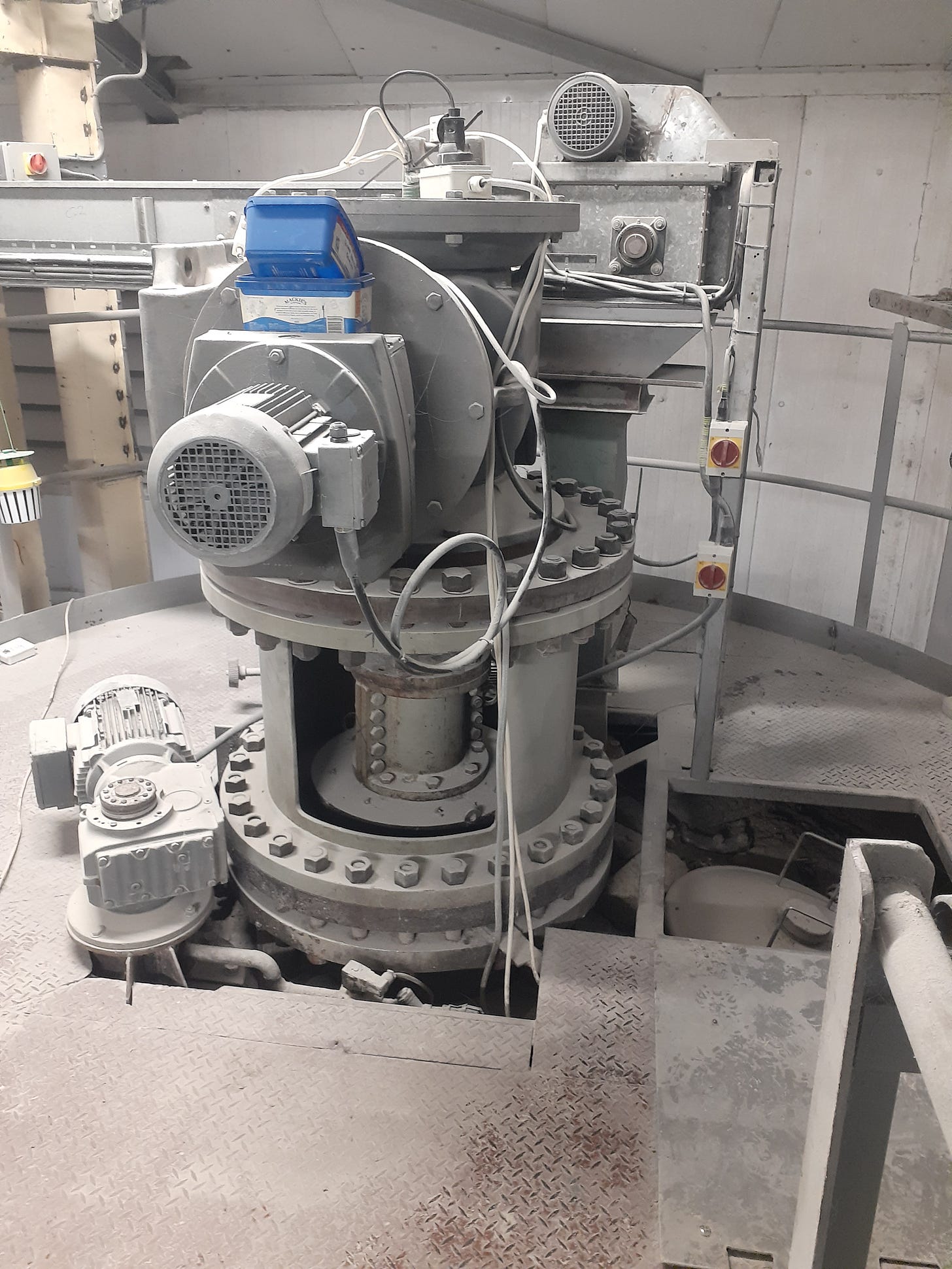
Then we get into another complicated story about supplying the kosher flour market. A UK based miller that used to supply the market is pulling out and Angus has been contacted as to the potential of making his operation kosher. It’s complicated because the quantities he would have to produce would push him over the “small” (50 tons/a) miller level exempt to the regulations to “fortify” his product (these are calcium, iron, thiamine (Vitamin B1) and niacin (Vitamin B3). These among other things don’t go with his existing “organic” image or the overall result when baked. Clearly though there is scope to expand his market and it’s something to consider.
We’re back into Haddington for dinner at the Waterside Bistro beside the River Tyne. Apparently the river floods from time to time so perhaps it should be renamed the “Underwater Waterfront Bistro”!
Beth spends most of the drive back into town with her eyes firmly shut as we’re now driving through very heavy fog and drizzly rain. Angus doesn’t appear to slow down for the conditions!
Angus is again greeted by name - this time with the more formal “good evening, Mr McDowall” and we get an excellent meal. We had hoped to meet Angus’s right hand flour milling and marketing co-ordinator Jennifer for dinner so Beth had someone more her own age to speak too but she can’t make it. Jennifer, who has taken over the job from her mother, has recently been diagnosed as a diabetic and isn’t feeling well tonight. She’s supposed to be manning the farmers’ market stall in the morning so that job will now probably fall to Angus before he heads off to Lochcarron later in the day. It doesn’t seem like a good idea to me to be driving at speed in the dark in the western highlands, but it doesn’t seem to bother Angus.
Talk turns to his 27-foot monohull sailing boat, coincidentally also called ‘Sonas’, which is anchored just offshore from the house at Lochcarron. He and his boat partner John Relph are meeting up this weekend to get the boat lifted out for the winter. Its main sail with battens furls into the boom and I think he said all the sheets come back to the helm making it OK to sail in most weather. They have made it as far as the Outer Hebrides on previous expeditions, and Angus aspires to stay for longer at Lochcarron in the summer months and do more sailing on “Sonas at Sea”.
There’s some talk of succession plans for Mungoswells which has been in the family since the 1920s. Angus, a bachelor, is looking to step back from full time work (he’s currently juggling management of all the farming, milling and malting roles) to go sailing amongst other things, perhaps even visit the relatives here in Australia! His nephew Corrin, Eleanor and Greg’s son, is not a farmer but has recently graduated with a business/commerce degree and will perhaps be interested in running Mungoswells as a business with the land leased or the work contracted out. The flour and malting businesses need more staff to expand - it’s the classic farm succession problem so we hope a plan is sorted out soon.
Angus quizzes Beth about her job in animation and she gives a rundown on her lucky start in the world of ‘Bluey’ and other projects she’s worked on. She explains that the big bucks don’t go to animators like her and that the work is on a contract basis - when there’s an interesting project on things are good but between times well, she travels the world like now!
We are again surprised to see dogs in restaurants - it’s not something you would see in Australia. There are two big dogs inside tonight, including this big white fluffy thing at the table beside us. It’s pretty well behaved but it does get in the way of the waitress as she’s trying to serve food and drinks to the table. The water bowl gets tipped over at one point too but no one seems to make a fuss - lucky it’s a timber floor!
We make our way back to Mungoswells to collect our car and head off to our accommodation in North Berwick. Luckily the pea-souper fog of earlier has lifted a bit so it’s not quite so scary for the 15-minute drive back to the coast. It’s been a big day!
Saturday 26/October/24
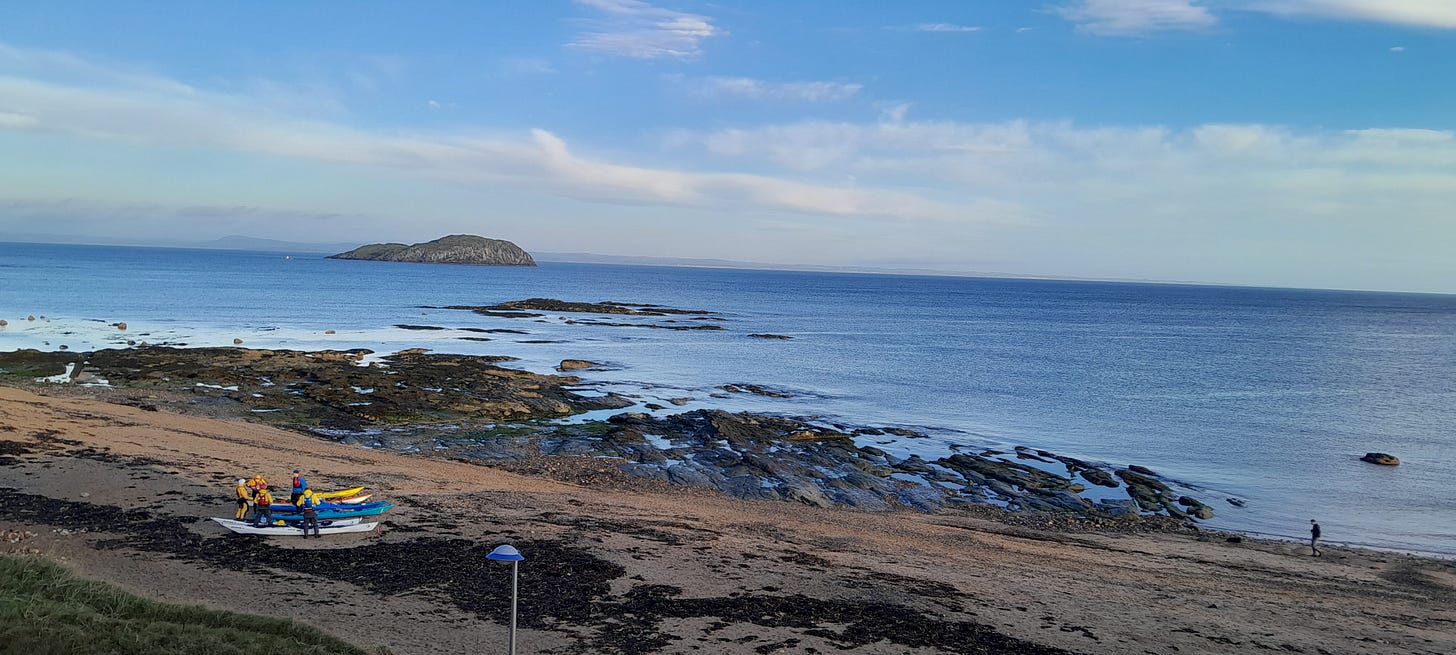
What a difference a day makes - after yesterday’s very dreich day (gloomy, overcast and damp) we wake up to some lovely sunshine. Ruth spots some paddlers bringing their kayaks down to the beach, and a swimmer stroking out across the ocean - these guys are tough! Eventually five paddlers are kitted out but it takes them forever to get down to the water’s edge. We think it must be a training run for some ‘newbies’.
We pack up and get all our gear back down the stairs and into the car - today we head for Chesterfield and the Peaks District in England.

